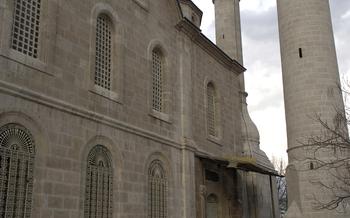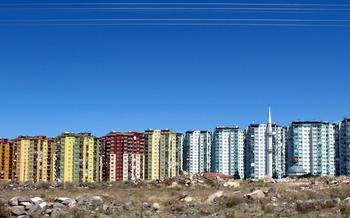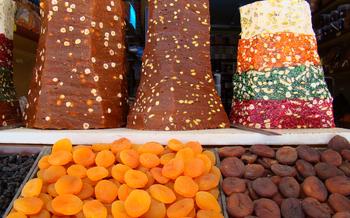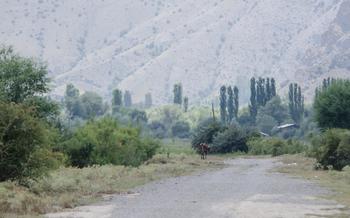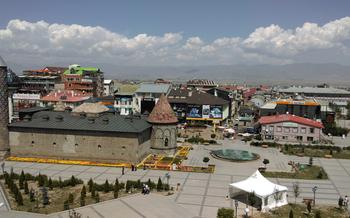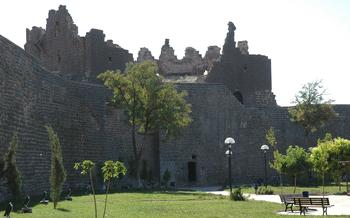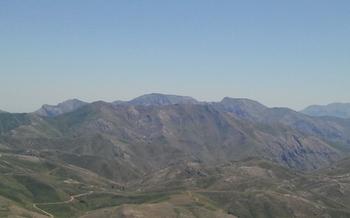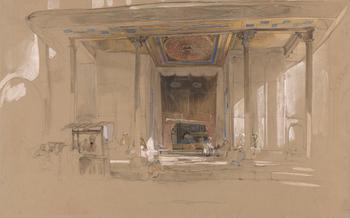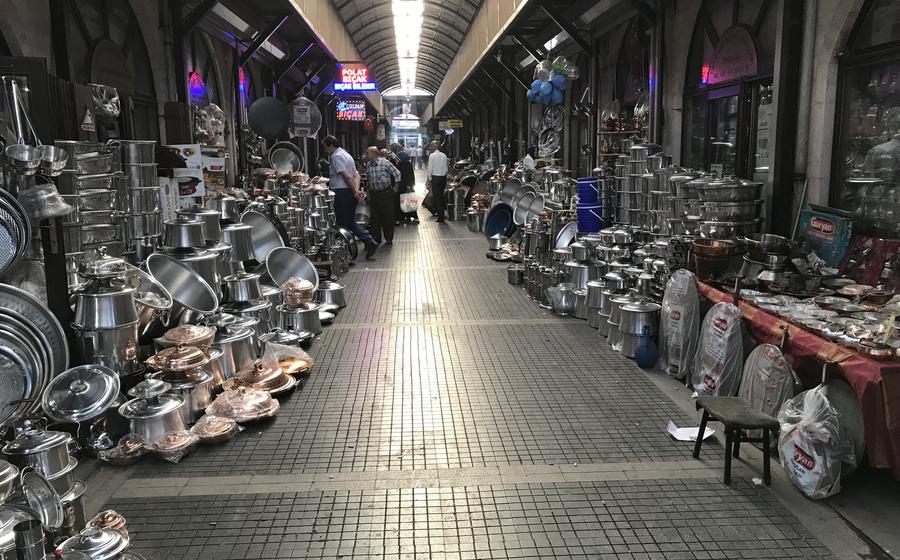
Seyit Battal Gazi Tomb
- Seyit Battal Gazi Tomb: A Sacred Mausoleum
- Location and Accessibility
- Visiting Hours and Admission Fees
- Exploring the Tomb Complex
- Historical Significance of Seyit Battal Gazi
- Legends and Folklore Surrounding Battal Gazi
- Battal Gazi's Influence on Modern Turkey
- Cultural Importance of the Tomb
- Architectural Features of the Tomb
- Legends and Stories
- Pilgrimage and Religious Significance
- Local Festivals and Celebrations
- Nearby Attractions and Landmarks
- Local Cuisine and Dining Options
- Accommodation and Lodging
- Shopping and Local Crafts
- Insider Tip: Off-the-Beaten-Path Experiences
Seyit Battal Gazi Tomb: A Sacred Mausoleum
The Seyit Battal Gazi Tomb stands as a revered monument in Malatya, Turkey, epitomizing the sacred legacy of the legendary figure Seyit Battal Gazi. This mausoleum holds immense historical and religious significance, attracting pilgrims and visitors from far and wide.
The tomb's construction dates back to the 12th century, commissioned by the Seljuk sultanate as a tribute to Seyit Battal Gazi, a revered warrior and saint in Turkish history and folklore. The tomb's design reflects a blend of Islamic and Seljuk architectural styles, featuring intricate carvings, graceful domes, and elegant arches.
Beyond its architectural beauty, the Seyit Battal Gazi Tomb holds deep religious significance. Seyit Battal Gazi is believed to have been a companion of the Prophet Muhammad and is revered as a saint in Islam. The tomb has become a pilgrimage site for Muslims, who come to pay homage and seek blessings.
Numerous legends and stories surround the tomb, adding to its mystique and allure. One legend tells of a miraculous spring that appeared at the site of Seyit Battal Gazi's martyrdom, its waters believed to possess healing properties. Another legend speaks of the tomb's protective powers, shielding the region from harm and misfortune.
Location and Accessibility
The Seyit Battal Gazi Tomb is situated in the heart of the city of Malatya, Turkey. Its exact address is Seyit Battal Gazi Caddesi, Merkez, Malatya. To reach the tomb, visitors can utilize various transportation options. Public buses and taxis are readily available, and the tomb is within walking distance from the city center. For those driving, GPS coordinates can be used for navigation: 3355169, 332094
In the vicinity of the tomb, there are several notable landmarks and attractions. The Malatya Museum, showcasing the region's rich history and artifacts, is just a short distance away. The Grand Mosque of Malatya, renowned for its stunning architecture, is another must-see destination. For a taste of local culture, visitors can explore the vibrant markets and bazaars, where they can find an array of traditional Turkish handicrafts and souvenirs.
When planning a visit to the Seyit Battal Gazi Tomb, it is advisable to choose a mode of transport that suits individual preferences and travel style. Whether opting for the convenience of public transportation, the flexibility of a taxi, or the freedom of driving, visitors will find it easy to reach this sacred site.
Visiting Hours and Admission Fees
The Seyit Battal Gazi Tomb is open to the public daily from 9:00 AM to 5:00 PM. Visitors can explore the tomb complex at their leisure, and there are usually local guides available to provide additional information and insights. Admission to the tomb is free of charge, making it an accessible attraction for travelers of all budgets.
Guided tours of the tomb are available upon request, and visitors should inquire at the entrance about booking a guide. Guided tours offer a deeper dive into the history and significance of the tomb, as well as the life of Seyit Battal Gazi. The recommended time of day to visit the tomb is in the morning or late afternoon, when the temperatures are more moderate and the lighting is ideal for photography.
Exploring the Tomb Complex
The Seyit Battal Gazi Tomb stands as a testament to the region's rich history and architectural prowess. Its interior and exterior boast a symphony of intricate carvings, elegant calligraphy, and captivating murals that narrate the life and legacy of Seyit Battal Gazi.
Upon entering the tomb, visitors are greeted by a serene atmosphere that invites contemplation and reverence. The walls are adorned with verses from the Quran and Hadith, adding to the spiritual significance of the space. The tomb itself is a marvel of craftsmanship, featuring intricate tilework and delicate carvings that showcase the skill and artistry of its creators.
Outside, the tomb is surrounded by lush gardens and tranquil courtyards, providing a serene oasis amidst the bustling city. Visitors can stroll through the gardens, admiring the colorful flowers and fragrant plants, or simply relax and soak in the tranquil ambiance.
Photography and videography are permitted within the tomb complex, allowing visitors to capture the beauty and grandeur of this sacred site. However, it's essential to be respectful of the religious significance of the tomb and to avoid disturbing other visitors.
Historical Significance of Seyit Battal Gazi
Seyit Battal Gazi, the legendary warrior and saint, holds a prominent place in Turkish history and culture. Born in the 7th century AD, he is renowned for his bravery, piety, and unwavering devotion to Islam. Battal Gazi's military prowess and conquests played a crucial role in the expansion of the Islamic empire during the early days of its formation. He led numerous successful campaigns against Byzantine forces, securing territories and establishing Muslim rule in various regions.
His heroic deeds and miraculous victories earned him the title of "Ghazi", meaning "Warrior of the Faith." Battal Gazi's reputation as a fearless warrior and a symbol of Islamic conquest spread throughout the empire, inspiring generations of Muslims to follow in his footsteps. His legacy extends beyond his military achievements, as he is also revered as a saint and a spiritual guide.
Legends and Folklore Surrounding Battal Gazi
The figure of Seyit Battal Gazi is deeply intertwined with Turkish folklore and mythology. Numerous legends and folktales have been passed down through generations, narrating his extraordinary feats and miraculous interventions. In these tales, Battal Gazi is often depicted as a larger-than-life hero, possessing superhuman strength and abilities.
One popular legend tells of Battal Gazi's encounter with a giant snake that terrorized a local village. With his unmatched bravery and unwavering faith, he slayed the monstrous serpent, saving the villagers from its deadly grip. Another tale recounts his miraculous victory over a Byzantine army using only a handful of soldiers, demonstrating his strategic genius and divine assistance.
Battal Gazi's Influence on Modern Turkey
The legacy of Seyit Battal Gazi continues to shape the cultural identity of modern Turkey. His unwavering commitment to faith and his heroic struggle against adversity serve as an inspiration to many Turks. His name and image are often invoked in popular culture, literature, and art, reinforcing his status as a national icon.
In addition to his historical significance, Battal Gazi is also revered as a symbol of Turkish nationalism and resistance against foreign occupation. His unwavering determination to defend his homeland against invaders resonates deeply with the Turkish people, who value their independence and sovereignty above all else.
Cultural Importance of the Tomb
The Seyit Battal Gazi Tomb holds immense cultural significance as a symbol of Turkish heritage and a pilgrimage site. It represents the deep-rooted faith and religious beliefs of the Turkish people, serving as a place of devotion and spiritual connection. The tomb is a testament to the rich history and traditions of Malatya, attracting numerous pilgrims and visitors from across the region.
The tomb's cultural significance extends beyond its religious importance. It plays a vital role in local traditions and festivals, becoming a focal point for community gatherings and celebrations. Every year, the tomb hosts vibrant festivals that showcase traditional music, folk dancing, and local cuisine. These events provide a glimpse into the vibrant cultural tapestry of Malatya, allowing visitors to immerse themselves in the local way of life.
Furthermore, the Seyit Battal Gazi Tomb has significantly contributed to the cultural identity of Malatya. The tomb's presence has shaped the city's cultural landscape, influencing local customs, beliefs, and practices. It has become an integral part of the city's story, attracting visitors who seek to understand and appreciate the unique heritage of Malatya.
Architectural Features of the Tomb
The Seyit Battal Gazi Tomb stands as a testament to the architectural prowess of the Seljuk era. Its distinctive design showcases a blend of Islamic and Anatolian influences, creating a visually striking and awe-inspiring structure. The tomb's exterior is adorned with intricate carvings and calligraphy, narrating tales of Seyit Battal Gazi's life and achievements. The interior, equally impressive, features a spacious chamber with a high dome supported by elegant arches. The walls are adorned with colorful tiles and intricate patterns, creating a serene and contemplative atmosphere. The tomb's architectural features not only add to its aesthetic appeal but also provide valuable insights into the artistic and cultural heritage of Turkey.
Legends and Stories
The Seyit Battal Gazi Tomb is shrouded in a mystical aura, with numerous legends and stories woven around its history. One popular tale speaks of a giant serpent that terrorized the region, demanding human sacrifices. Seyit Battal Gazi, known for his bravery and strength, volunteered to slay the beast. After a fierce battle, he emerged victorious, earning the gratitude and admiration of the people.
Another legend tells of a miraculous spring that emerged from the ground where Seyit Battal Gazi's horse struck its hoof. The water from this spring is believed to possess healing properties, attracting pilgrims and visitors seeking divine blessings.
Stories of Seyit Battal Gazi's extraordinary feats of strength and courage have been passed down through generations. He is often depicted as a valiant warrior, defending the weak and oppressed against evil forces. These legends have contributed to the tomb's significance as a place of pilgrimage and reverence.
Pilgrimage and Religious Significance
The Seyit Battal Gazi Tomb holds profound religious significance, attracting numerous pilgrims throughout the year. Devotees from across Turkey and beyond visit the tomb to pay their respects to Seyit Battal Gazi, seeking blessings and spiritual fulfillment. Muslims believe that visiting the tombs of saints and righteous individuals brings divine favor and intercession.
Pilgrims engage in various rituals and practices at the tomb. They offer prayers, recite verses from the Quran, and make supplications to Seyit Battal Gazi, seeking his guidance and assistance. Many visitors also light candles and leave offerings, such as flowers or tokens of gratitude, at his shrine.
The tomb is known for its sacred atmosphere, where pilgrims experience a sense of tranquility and spiritual connection. It is believed that the tomb possesses miraculous powers, and many visitors share stories of healing, guidance, and answered prayers after visiting the site.
For Muslims, the Seyit Battal Gazi Tomb represents a pilgrimage site of great importance, where they can honor a revered figure and seek spiritual guidance and blessings.
Local Festivals and Celebrations
The Seyit Battal Gazi Tomb is not only a historical and religious site but also a vibrant center for local festivals and celebrations. Throughout the year, the tomb complex hosts various events that showcase Turkish culture and traditions. One of the most significant festivals is the annual Seyit Battal Gazi Commemoration Festival, held in his honor. This festival attracts thousands of pilgrims and visitors from across Turkey and beyond. During the festival, colorful processions, traditional music and dance performances, and religious ceremonies take place. Food stalls offering local delicacies and handicrafts stalls selling souvenirs and traditional Turkish crafts add to the festive atmosphere. Participating in these festivals is an excellent opportunity to immerse yourself in the rich cultural heritage of Malatya and experience the warmth and hospitality of its people.
Nearby Attractions and Landmarks
Malatya is home to a wealth of historical sites, natural wonders, and cultural attractions that complement a visit to the Seyit Battal Gazi Tomb. Immerse yourself in the region's rich past at the Malatya Museum, housing artifacts from various civilizations that once graced these lands. Marvel at the architectural splendor of the Ulu Cami, a magnificent mosque dating back to the 13th century.
Venture into the scenic landscapes surrounding Malatya, where nature's beauty takes center stage. Explore the enchanting Gölbaşı National Park, with its tranquil lake, lush greenery, and diverse wildlife. Embark on a hiking adventure in the majestic Taurus Mountains, offering breathtaking views and challenging trails for outdoor enthusiasts.
For those seeking cultural experiences, Malatya offers several museums and cultural centers that showcase the region's vibrant traditions and heritage. Delve into the world of apricots at the Malatya Apricot Museum, celebrating the city's renowned fruit. Immerse yourself in the captivating displays at the Malatya Ethnography Museum, providing a glimpse into the local way of life and customs.
To make the most of your time in Malatya, plan an itinerary that allows you to seamlessly blend a visit to the Seyit Battal Gazi Tomb with explorations of the region's other captivating attractions. Whether you're drawn to history, nature, or culture, Malatya has something to offer every traveler.
Local Cuisine and Dining Options
When visiting the Seyit Battal Gazi Tomb, take the opportunity to savor the delectable flavors of Malatya's local cuisine. The city is renowned for its rich culinary heritage, influenced by Turkish, Kurdish, and Armenian traditions. Here are some must-try dishes and dining recommendations:
-
Try the iconic kayısı dishes: Malatya is famous for its apricots, and they feature prominently in local cuisine. Indulge in kayısı dolması (stuffed apricots), kayısı çorbası (apricot soup), and kayısı tatlısı (apricot dessert).
-
Explore street food delights: Take a stroll through the city's vibrant streets and sample delicious street food. Look out for çiğ köfte (raw meatballs), lahmacun (Turkish pizza), and künefe (shredded pastry with cheese and syrup).
-
Visit traditional restaurants: Experience the authentic ambiance of Malatya's traditional restaurants. Enjoy a leisurely meal of dishes like Malatya tavası (meat and vegetable stew), erişte çorbası (noodle soup), and patlıcan kebabı (eggplant kebab).
-
Vegetarian options: Malatya offers plenty of vegetarian-friendly dishes. Try kuru fasulye (white bean stew), mercimek çorbası (lentil soup), and gözleme (stuffed flatbread).
-
Local markets: Immerse yourself in the local culture by visiting the bustling markets. Discover fresh produce, spices, and traditional delicacies. Don't miss the opportunity to haggle with vendors and experience the vibrant atmosphere.
Accommodation and Lodging
When planning your visit to the Seyit Battal Gazi Tomb, finding suitable accommodation in Malatya is essential. The city offers a range of options to suit different budgets and preferences.
For a comfortable and convenient stay, consider booking a hotel near the tomb. Several reputable hotels are located within walking distance, providing easy access to the site and other attractions. Be sure to check online reviews, compare prices, and book in advance to secure the best deals.
If you're on a tight budget, there are budget-friendly options available. Hostels and guesthouses offer dorm-style accommodations or private rooms at affordable rates. These establishments often have a friendly atmosphere and provide opportunities to socialize with fellow travelers.
For a truly immersive experience, consider staying in a homestay. This is a great way to connect with locals, learn about their culture, and enjoy traditional Turkish hospitality. Homestays typically offer simple but comfortable accommodations and the chance to sample delicious home-cooked meals.
No matter your budget or preferences, there are plenty of accommodation options in Malatya to choose from. Remember to book your stay in advance, especially during peak tourist seasons, to avoid disappointment.
Shopping and Local Crafts
Shopping in Malatya is a delight for those seeking unique souvenirs and local crafts. The city is renowned for its traditional Turkish carpets, known for their intricate designs and vibrant colors. Visitors can find a wide selection of carpets at the local bazaars and shops, where bargaining is not only acceptable but expected.
Beyond carpets, Malatya is home to a variety of handicrafts and textiles, such as hand-woven rugs, embroidered fabrics, and pottery. These items make for excellent gifts or keepsakes, showcasing the skill and artistry of local artisans.
When shopping in Malatya, be sure to visit the traditional markets or bazaars, where you can immerse yourself in the vibrant local atmosphere. These markets offer a treasure trove of goods, from fresh produce and spices to clothing and household items. Haggling is a common practice, so don't be afraid to negotiate for a good price.
Insider Tip: For a truly authentic experience, visit the weekly livestock market held on the outskirts of Malatya. This bustling market offers a glimpse into the region's agricultural heritage and provides a unique opportunity to witness the trading of animals, from sheep and goats to horses and donkeys.
Insider Tip: Off-the-Beaten-Path Experiences
While exploring Malatya, don't miss the opportunity to venture off the beaten path and discover hidden gems that offer a unique glimpse into local life and culture. Here are a few insider tips:
-
Discover the Malatya Museum, a treasure trove of artifacts and exhibits showcasing the rich history and cultural heritage of the region.
-
Explore the Malatya Castle, a magnificent fortress that stands as a testament to the city's strategic importance throughout the ages.
-
Immerse yourself in the flavors of Malatya's cuisine by visiting local markets and trying street food delicacies like Malatya kebap, kayısı dolması (stuffed apricots), and cevizli sucuk (walnut sausage).
-
Take a scenic hike or picnic in the Malatya Mountains, enjoying breathtaking views and the tranquility of nature.
-
For a unique cultural experience, visit the Malatya Halk Oyunları Merkezi (Folk Dance Center), where you can learn traditional Turkish folk dances and immerse yourself in the vibrant local culture.
Remember, sometimes the most rewarding experiences come from exploring beyond the main tourist attractions and embracing the authentic charm of a destination.
